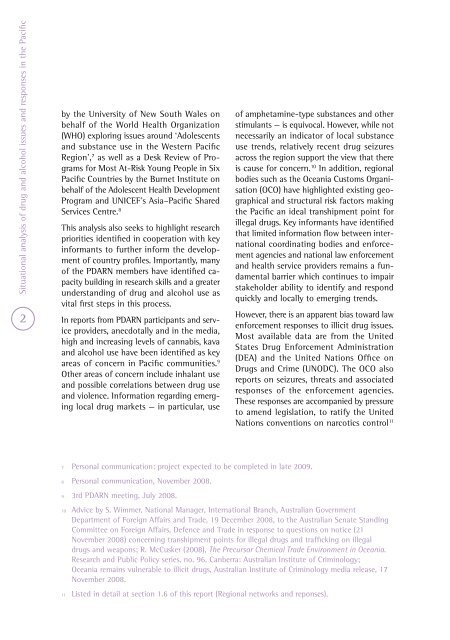rp21 situational analysis - Pacific Health Voices
rp21 situational analysis - Pacific Health Voices
rp21 situational analysis - Pacific Health Voices
Create successful ePaper yourself
Turn your PDF publications into a flip-book with our unique Google optimized e-Paper software.
Situational <strong>analysis</strong> of drug and alcohol issues and responses in the <strong>Pacific</strong><br />
2<br />
by the University of New South Wales on<br />
behalf of the World <strong>Health</strong> Organization<br />
(WHO) exploring issues around ‘Adolescents<br />
and substance use in the Western <strong>Pacific</strong><br />
Region’, 7 as well as a Desk Review of Programs<br />
for Most At-Risk Young People in Six<br />
<strong>Pacific</strong> Countries by the Burnet Institute on<br />
behalf of the Adolescent <strong>Health</strong> Development<br />
Program and UNICEF’s Asia–<strong>Pacific</strong> Shared<br />
Services Centre. 8<br />
This <strong>analysis</strong> also seeks to highlight research<br />
priorities identified in cooperation with key<br />
informants to further inform the development<br />
of country profiles. Importantly, many<br />
of the PDARN members have identified capacity<br />
building in research skills and a greater<br />
understanding of drug and alcohol use as<br />
vital first steps in this process.<br />
In reports from PDARN participants and service<br />
providers, anecdotally and in the media,<br />
high and increasing levels of cannabis, kava<br />
and alcohol use have been identified as key<br />
areas of concern in <strong>Pacific</strong> communities. 9<br />
Other areas of concern include inhalant use<br />
and possible correlations between drug use<br />
and violence. Information regarding emerging<br />
local drug markets — in particular, use<br />
of amphetamine-type substances and other<br />
stimulants — is equivocal. However, while not<br />
necessarily an indicator of local substance<br />
use trends, relatively recent drug seizures<br />
across the region support the view that there<br />
is cause for concern. 10 In addition, regional<br />
bodies such as the Oceania Customs Organisation<br />
(OCO) have highlighted existing geographical<br />
and structural risk factors making<br />
the <strong>Pacific</strong> an ideal transhipment point for<br />
illegal drugs. Key informants have identified<br />
that limited information flow between international<br />
coordinating bodies and enforcement<br />
agencies and national law enforcement<br />
and health service providers remains a fundamental<br />
barrier which continues to impair<br />
stakeholder ability to identify and respond<br />
quickly and locally to emerging trends.<br />
However, there is an apparent bias toward law<br />
enforcement responses to illicit drug issues.<br />
Most available data are from the United<br />
States Drug Enforcement Administration<br />
(DEA) and the United Nations Office on<br />
Drugs and Crime (UNODC). The OCO also<br />
reports on seizures, threats and associated<br />
responses of the enforcement agencies.<br />
These responses are accompanied by pressure<br />
to amend legislation, to ratify the United<br />
Nations conventions on narcotics control 11<br />
7 Personal communication: project expected to be completed in late 2009.<br />
8 Personal communication, November 2008.<br />
9 3rd PDARN meeting, July 2008.<br />
10 Advice by S. Wimmer, National Manager, International Branch, Australian Government<br />
Department of Foreign Affairs and Trade, 19 December 2008, to the Australian Senate Standing<br />
Committee on Foreign Affairs, Defence and Trade in response to questions on notice (21<br />
November 2008) concerning transhipment points for illegal drugs and trafficking on illegal<br />
drugs and weapons; R. McCusker (2008), The Precursor Chemical Trade Environment in Oceania.<br />
Research and Public Policy series, no. 96. Canberra: Australian Institute of Criminology;<br />
Oceania remains vulnerable to illicit drugs, Australian Institute of Criminology media release, 17<br />
November 2008.<br />
11 Listed in detail at section 1.6 of this report (Regional networks and reponses).
















